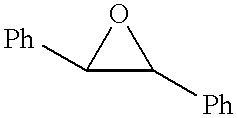Separating agent for optical isomers and process for producing the same
a technology of optical isomers and separation agents, which is applied in the separation of optically-active compounds, chemical/physical processes, organic chemistry methods, etc., can solve the problems of limited solvents in which samples are to be dissolved, the inability to use separation agents, and the inability to use polysaccharide derivatives as mobile phases, etc., to achieve the effect of high optical resolving power inherent in polysaccharide derivatives, short process steps, and high solvent resistan
- Summary
- Abstract
- Description
- Claims
- Application Information
AI Technical Summary
Problems solved by technology
Method used
Image
Examples
example 1
Synthesis of separating agent having cellulose tris(3,5-dimethylphenyl)carbamate immobilized on silica gel with the use of sytrene-divinylbenzene copolymer
(1) Surface-treatment of silica gel
A porous silica gel (SP-1000, mfd. by Daiso, particle diameter: 7 .mu.m, average pore size: 1000 .ANG.) was subjected to aminopropylsilane (APS) treatment in a conventional manner by reacting with 3-aminopropyltriethoxysilane.
(2) Synthesis of cellulose tris(3,5-dimethylphenyl)carbamate (CDMPC)
In a nitrogen atmosphere, 10 g of cellulose (Microcrystalline Avicel, mfd. by Merck & Co., Inc.) and 42 g of 3,5-dimethylphenyl isocyanate were heated at 100.degree. C. under stirring for 48 hours in 100 ml of dry pyridine. Next, the reaction mixture was poured into 2 l of methanol. The solid thus precipitated was taken up by filtration through a glass filter and washed with methanol several times followed by vacuum drying (80.degree. C., 5 hr).
(3) Supporting of cellulose carbamate derivative on silica gel
2....
example 2
Synthesis of separating agent having cellulose tris(3,5-dimethylphenyl)carbamate immobilized on silica gel with the use of sytrene-divinylbenzene copolymer
(1) Surface-treatment of silica gel
A porous silica gel was subjected to the APS treatment in the same manner as the one described in Example 1(1).
(2) Synthesis of cellulose tris(3,5-dimethylphenyl)carbamate (CDMPC)
Cellulose tris(3,5-dimethylphenyl)carbamate was obtained in the same manner as the one described in Example 1(2).
(3) Supporting of cellulose carbamate derivative on silica gel
2.0 g of the cellulose tris(3,5-dimethylphenyl)carbamate obtained in the step (2) was supported on 8.0 g of the APS-treated silica gel obtained in the step (1) by using the same technique as the one described in Example 1(3).
(4) Formation of polymer coating on silica gel supporting polysaccharide derivative polymer thereon and immobilization of polysaccharide derivative polymer:
St and DVB were employed at the ratio as specified in Table 2 while AIBN...
example 3
Synthesis of separating agent having cellulose tris(3,5-dimethylphenyl)carbamate immobilized on silica gel with the use of sytrene-divinylbenzene copolymer
(1) Surface-treatment of silica gel
A porous silica gel was subjected to the APS treatment in the same manner as the one described in Example 1(1).
(2) Synthesis of cellulose tris(3,5-dimethylphenyl)carbamate (CDMPC)
Cellulose tris(3,5-dimethylphenyl)carbamate was obtained in the same manner as the one described in Example 1(2).
(3) Supporting of cellulose carbamate derivative on silica gel
The cellulose tris(3,5-dimethylphenyl)carbamate obtained in the step (2) was immobilized on the APS-treated silica gel obtained in the step (1) by using the same technique as the one described in Example 1(3).
(4) Formation of polymer coating on silica gel supporting polysaccharide derivative polymer thereon and immobilization of polysaccharide derivative polymer:
St and DVB were employed at a weight ratio of 1 / 1 while AIBN was employed at a weight ra...
PUM
| Property | Measurement | Unit |
|---|---|---|
| pore size | aaaaa | aaaaa |
| pore size | aaaaa | aaaaa |
| pore size | aaaaa | aaaaa |
Abstract
Description
Claims
Application Information
 Login to View More
Login to View More - R&D
- Intellectual Property
- Life Sciences
- Materials
- Tech Scout
- Unparalleled Data Quality
- Higher Quality Content
- 60% Fewer Hallucinations
Browse by: Latest US Patents, China's latest patents, Technical Efficacy Thesaurus, Application Domain, Technology Topic, Popular Technical Reports.
© 2025 PatSnap. All rights reserved.Legal|Privacy policy|Modern Slavery Act Transparency Statement|Sitemap|About US| Contact US: help@patsnap.com



